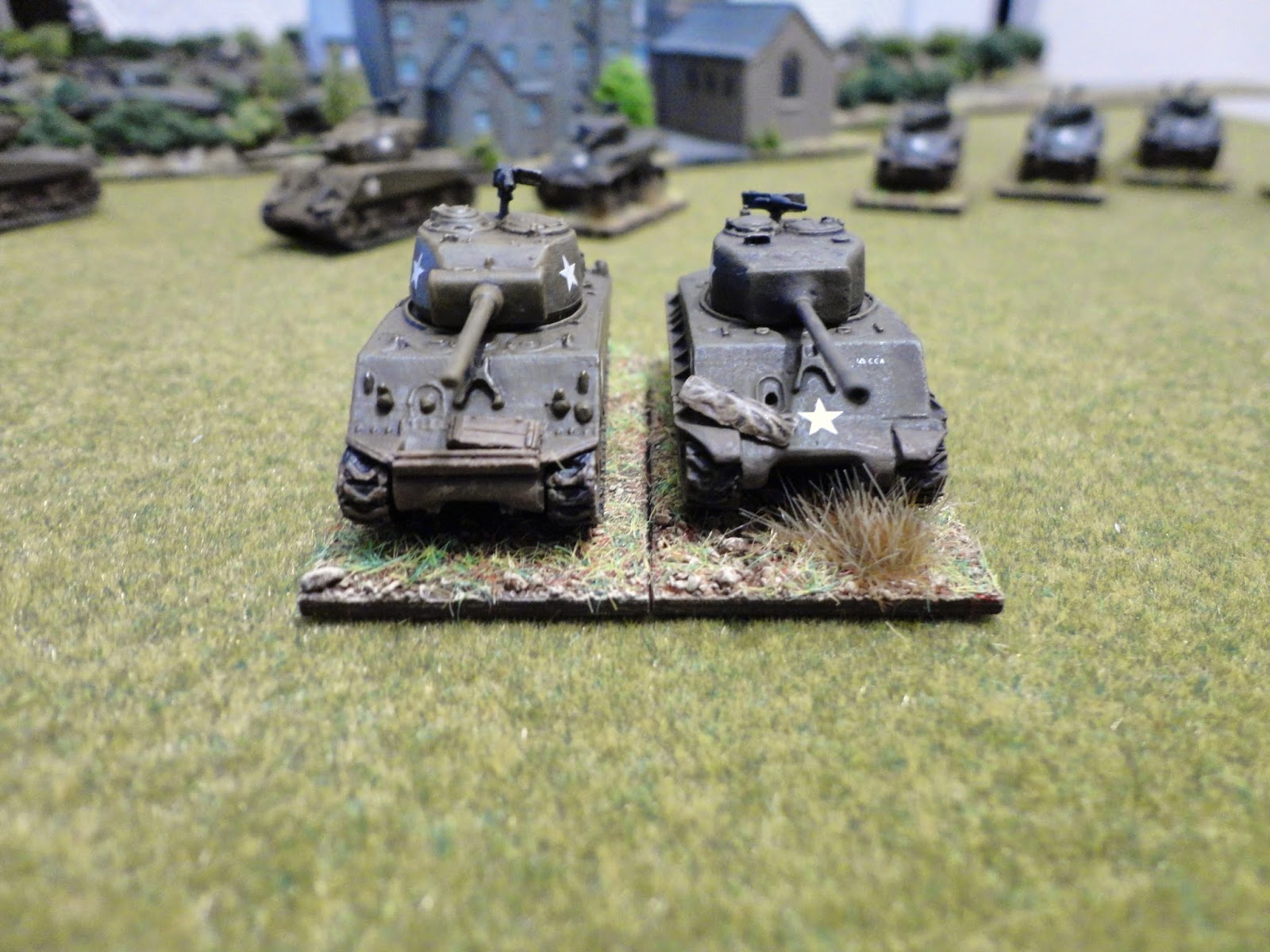My first substantial post on WW2 and I will go through some of my US armor units (to note I have used the American spelling but it will be armour when I do the British!).
A photo of the overall force: 5 platoons with HQ and a light tank platoon. I will go through each part of the force in detail below and I will discuss each individual vehicle and touch on manufacturer comparisons etc. as I go.
Sherman M4A1: Takara
These are simply the Takara M3A3 turret put on the Takara M4 76mm body - and I have done the other way round too as you will see below. While I will mainly use later Shermans in my games this gives me the option to field a platoon of the earlier version. Other than using a wash to weather the vehicles they are as they originally came except that I have added an Allied star on the back of the platoon command tank.
The platoon is travelling through the 'Town' so I will take this opportunity to say a bit about it.
The buildings are all 6mm TimeCast - painted by TimeCast and based by me. I will do later posts on what materials etc. I use to base up buildings. The specific buildings are:
- the nearest is 3/021 Berlin Town Houses and apartments;
- across the street is 6/003 French village street;
- and 6/005 Dutch church.
As you can see from the close up photos the buildings work very well for WW2 and also with 10/ 12mm scale (if you put a figure up against a door it would look too small but the effect of the overall size comparison on a games table feels right to me).
.
Stuart M5 light tank: Arrowhead Miniatures (or Wargames South as they were when I actually bought them)
These are a multi-part metal kit which I have built and painted. I used a darker green than for other tanks and it does not photo quite as well so I have added an extra photo taken against a white background. Numerous Allied star decals added - it really livens up tanks when you can add national and unit markings. I will do a later post about decals including what I use and how to apply. I have based all my metal tanks as it helps to protect from paint being damaged (the bottom and edges of the tracks are a particular problem).
Size wise they look fine against the M4s and as all my Stuart versions for the Americans are Arrowhead then they fit in no problem at all.
Sherman M4A3E8: Arrowhead Miniatures
this is an older model and just comes as the hull, separate tracks, the turret and a roof top MG rather than the many part kits of their later models. I have added various bits of stowage from the plastic sets that come with most Takara models. The decals I have added include the vehicle registration number on the side - which is a pain to put on as it is difficult to see on the decal sheet being very small and white on a light background, but adds to the look of the finished tank. I will be expanding my number of this version when I get round to doing American vehicles again.

Now for some size comparisons. As you can see below the Arrowhead tank is very slightly smaller than the M4A3 76mm Takara (I have sat that on a base to allow better comparison - and this is a debate I am still having with myself, whether to base all my tanks or not). But the difference is so slight it is not noticeable in general use. However, this is an older Arrowhead model and they did tend to be a bit smaller than plastic 1/144 but the new Arrowhead models are a bit larger than the plastic equivalent - not to the extent that they can't be used together particularly if not the exact same tank. You will be able to see more comparisons in later posts.
Sherman M4A3 76mm: Takara
This is the other half of the swap I mentioned above - the turret from the Takara M4 76mm and the hull from the Takara M4A3. These I have repainted and added new decals, plus some of the Takara stowage that you get with their tanks, plus a metal roof top MG from Pendraken. I really like they way these have turned out.
This one is painted up as the tank of Lt. Col. Creighton Abrams. Other than painting on his distinctive tank markings I have added a commander which is an Arrowhead figure.
Company command - M4 105mm and M32 recovery: Takara and Metal Troops
The command platoon has along with the two standard M4A3s an M4 105mm plus an M32 recovery tank.
The M4 105mm I converted by cutting off the gun and adding a tube to represent the 105mm howitzer. The M32 is a Metal Troops vehicle and comes with anti-mine rollers.
Sherman M4A3: Takara
The normal Takara Sherman but I have added a roof top MG using a Pendraken metal MG and added the Cullen prong hedge cutter to two tanks per platoon (again from Pendraken). Other than that some extra decals and weathering.
Sherman M4A1 76mm: Takara
the normal Takra M4 76mm but repainted, new decals and stowage on some. The one in front is painted up as the tank of Staff Sergeant Lafeyette Pool. So in addition it has a commander figure, roof top MG, track added on the turret sides and hull plus a Cullen prong hedge cutter.
I will do later posts covering American Tank Destroyers, artillery, infantry and various support units. I will also be doing the other main nations - and they have a lot more tanks so will probably take several posts to cover.




























































